Research on Best Solution for Improving Indoor Air Quality and Reducing Energy Consumption in a High-Risk Radon Dwelling from Romania
Abstract
:1. Introduction
2. Pilot Building Description
- Thickness (m): 0.41 m
- U-value surface to surface (W/m2-k): 0.341
- R-Value (m2-k/W): 3101
- Thickness (m): 0.14
- U-value surface to surface (W/m2-k): 1.034
- R-Value (m2-k/W): 1237
- Total solar transmission (SHGC): 0.691;
- Direct solar transmission: 0.624;
- Light transmission: 0.744;
- U–value: 2.6 (W/m2-k).
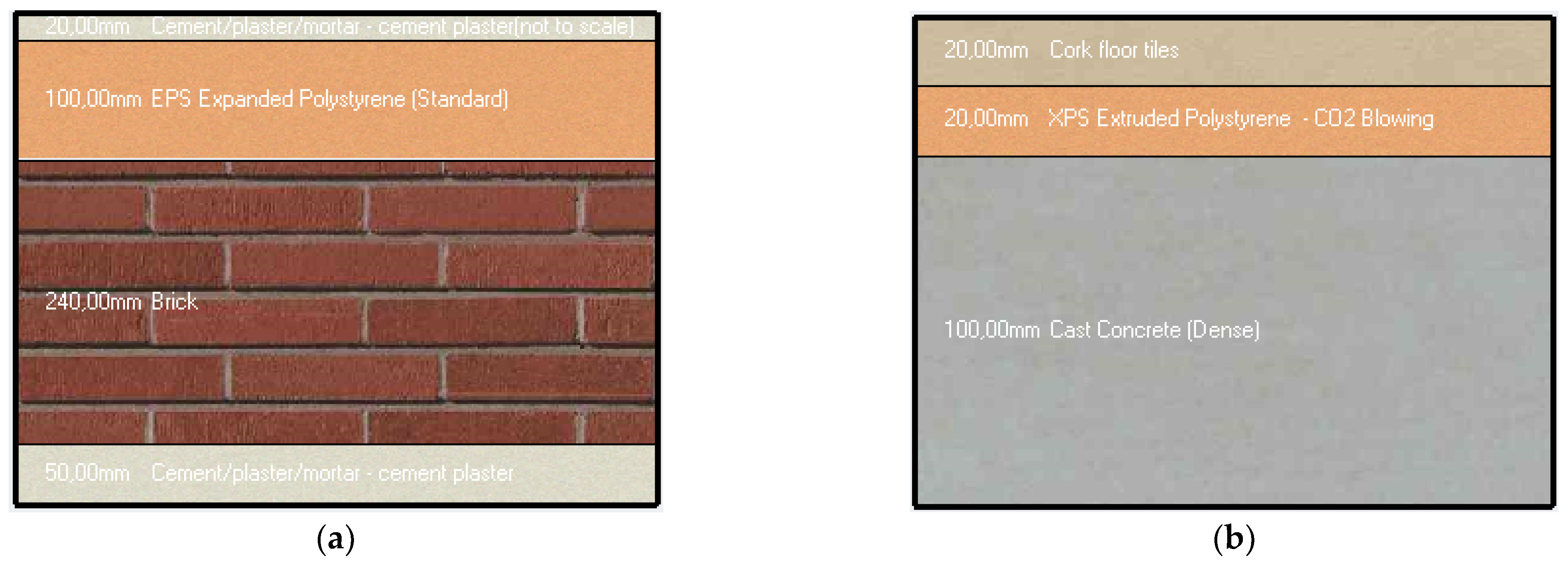
3. Numerical Evaluation of Energy Consumption
- Weekdays SummerDesignDay, until: 09:00, full flow, until: 20:00, half flow, until: 24:00, full flow;
- WinterDesignDay, until: 09:00, full flow, until: 20:00, half flow, until: 24:00, full flow.
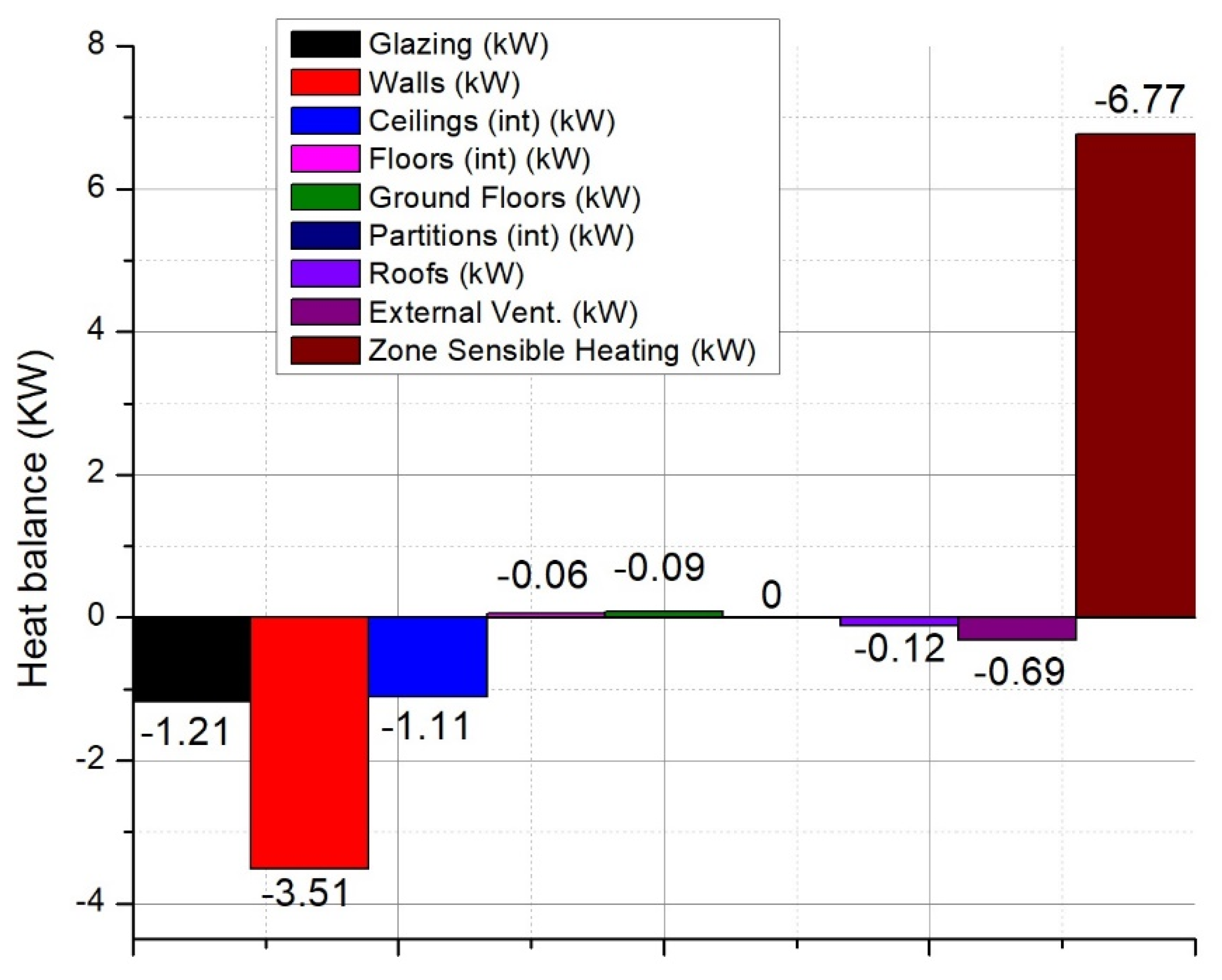
4. Experimental Evaluation of Indoor Environment and Energy Consumption
5. Research on the Optimal Solution
- ➢
- Relatively small investment.
- ➢
- Simple installation, from the outside, without damaging the interior.
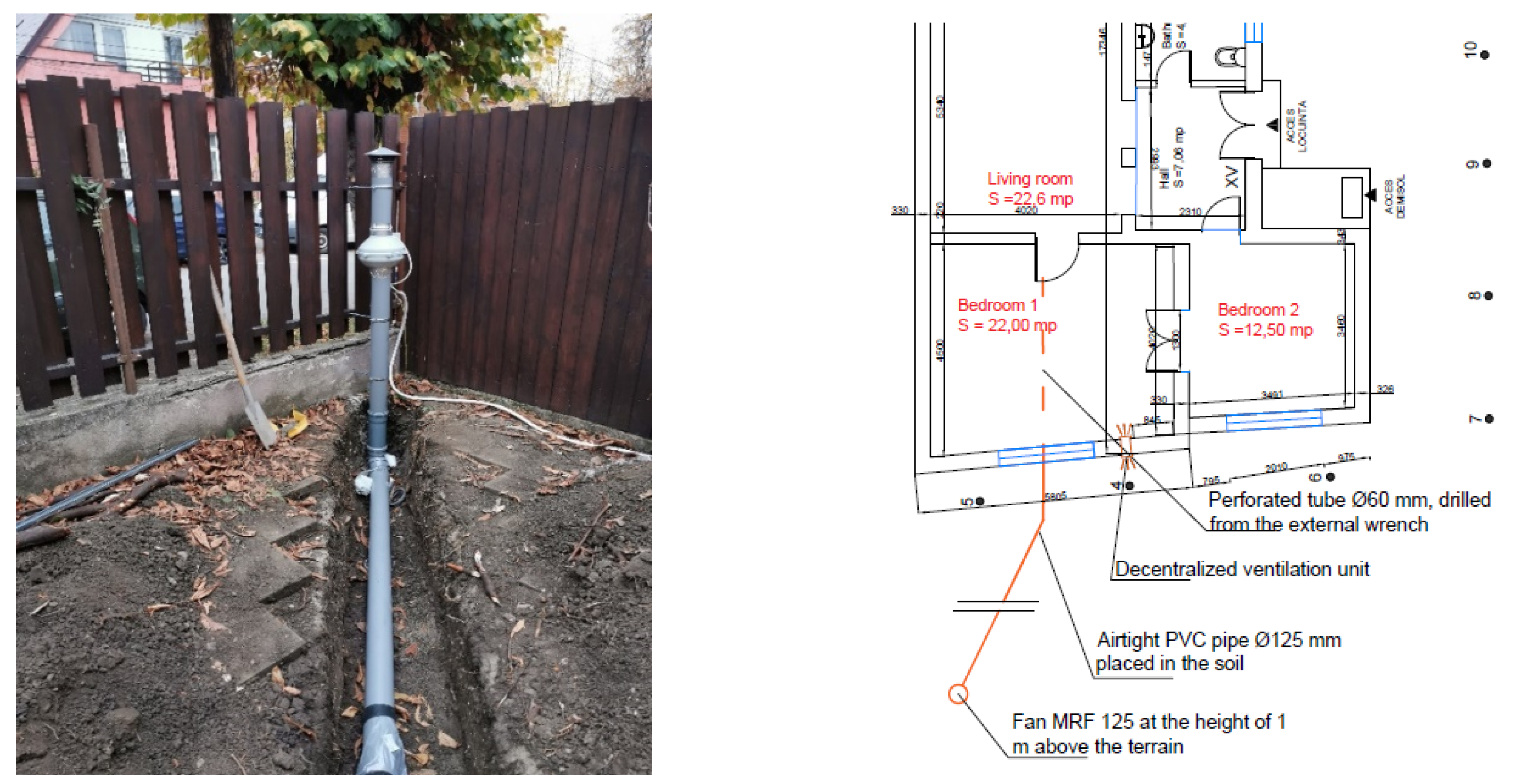
6. Mathematical and Numerical Determination
7. Conclusions
- (1)
- The novelty of this study came from the interconnection of radon mitigation methods with indoor air quality and building energy efficiency. Many studies have shown that radon mitigation by a Sub-slab depressurization system may reach efficiency values of about 95%. This method mitigates the radon concentration indoor, but, in some cases, this method cannot be applied. Another solution to mitigate the indoor radon level, when the concentration is not too much exceeded, may be the installation of ventilation equipment. This method showed a radon reduction efficiency between 25–67%.
- (2)
- The simulations and the energy certification of the building demonstrated that the heating demand is low, and the building can be classified as an energy-efficient one. On the other hand, the indoor measurements conducted during the winter period have shown high radon concentrations up to 2000 Bq/m3 for a particular room during nighttime when the house was occupied, and air sealed as the windows were completely closed. After the mitigation method has been applied, the radon level decreased below 150 Bq/m3, showing a very good improvement for the indoor air quality.
- (3)
- Using the mitigation systems, the temperature stabilizes at the setpoint, 21 °C, not oscillating anymore to low values. While the indoor air temperature presented a comfortable value and the heating system was functioning in good energy parameters, the indoor relative humidity established to a normal level of 750 ppm, high values like before the installation of mitigation system were not recorded anymore.
- (4)
- Another great advantage of using this mitigation system is the reduction of energy loss, showing approximately 86% efficiency of the ventilation equipment (average known efficiency).
Author Contributions
Funding
Institutional Review Board Statement
Informed Consent Statement
Data Availability Statement
Conflicts of Interest
References
- The European Parliament and The Council of The European Union, Directive (EU) 2018/2002 of the European Parliament and of the Council of 11 December 2018 amending Directive 2012/27/EU on energy efficiency. Off. J. Eur. Union 2018, 328, 210–230.
- Amasyali, K.; El-Gohary, N.M. A review of data-driven building energy consumption prediction studies. Renew. Sustain. Energy Rev. 2018, 81, 1192–1205. [Google Scholar] [CrossRef]
- Fernandes, J.; Malheiro, R.; Castro, M.D.F.; Gervásio, H.; Silva, S.M.; Mateus, R. Thermal Performance and Comfort Condition Analysis in a Vernacular Building with a Glazed Balcony. Energies 2020, 13, 624. [Google Scholar] [CrossRef] [Green Version]
- Chen, Z.; Shi, M.; Guoc, H.; Xu, L. Analysis on Energy Consumption of Some Comprehensive Office Building in Jinan. Procedia Eng. 2017, 205, 3769–3774. [Google Scholar] [CrossRef]
- Ruano, A.E.; Crispim, E.M.; Conceiçao, E.Z.; Lúcio, M.M.J. Prediction of building’s temperature using neural networks models. Energy Build. 2006, 38, 682–694. [Google Scholar] [CrossRef]
- Iturra, E.E.M. Impact De La Configuration Des Bâtiments Scolaires Sur Leur Performance Lumineuse, Thermique Et Énergétique. Master’s Thesis, Faculté D’Aménagement, D’Architecture Et Des Arts Visuels Université Laval Québec, Québec, QC, Canada, 2011. [Google Scholar]
- Liu, D.; Wang, W.; Liu, J. Sensitivity Analysis of Meteorological Parameters on Building Energy Consumption. Energy Procedia 2017, 132, 634–639. [Google Scholar] [CrossRef]
- Ashok, G.V.; Nagaiah, N.; Shiva Prasad, N.G. Indoor radon concentration and its possible dependence on ventilation rate and flooring type. Radiat. Prot. Dosim. 2012, 148, 92–100. [Google Scholar] [CrossRef]
- Tibermacine, I.; Zemmouri, N. Effects of building typology on energy consumption in hot and arid regions. Energy Procedia 2017, 139, 664–669. [Google Scholar] [CrossRef]
- Iordache, V.; Catalina, T. Acoustic approach for building air permeability estimation. Build. Environ. 2012, 57, 18–27. [Google Scholar] [CrossRef]
- Yan, D.; Hong, T.; Li, C.; Zhang, Q.; An, J.; Hu, S. A thorough assessment of China’s standard for energy consumption of buildings. Energy Build. 2017, 143, 114–128. [Google Scholar] [CrossRef] [Green Version]
- Bordbari, M.J.; Seifi, A.R.; Rastegar, M. Probabilistic Energy Consumption Analysis in Buildings Using Point Estimate Method. Energy 2017, 142, 716–722. [Google Scholar] [CrossRef]
- Pampuri, L.; Caputo, P.; Valsangiacomo, C. Effects of buildings’ refurbishment on indoor air quality. Results of a wide survey on radon concentrations before and after energy retrofit interventions. Sustain. Cities Soc. 2018, 42, 100–106. [Google Scholar] [CrossRef]
- Order nr. 1659 of the Minister of Regional Development and Tourism, Normative for the Design, Execution and Operation of Ventilation and Air Conditioning Installations, Indicative I5-2010, Official Gazette First Part; Ministry of Regional Development and Tourism: Bucharest, Romania, 2011.
- Lei, Z.; Liu, C.; Wang, L.; Li, N. Effect of natural ventilation on indoor air quality and thermal comfort in dormitory during winter. Build. Environ. 2017, 125, 240–247. [Google Scholar] [CrossRef]
- Vasilescu, A. CR-39 Sampling of indoor radon in southern Romania. Rom. J. Phys. 2013, 58, 311–319. [Google Scholar]
- Akbari, K.; Mahmoudi, J.; Ghanbari, M. Influence of indoor air conditions on radon concentration in a detached house. J. Environ. Radioact. 2013, 116, 166–173. [Google Scholar] [CrossRef]
- Guyot, G.; Sherman, M.H.; Walker, I.S. Smart ventilation energy and indoor air quality performance in residential buildings: A review. Energy Build. 2018, 165, 416–430. [Google Scholar] [CrossRef] [Green Version]
- Elío, J.; Crowley, Q.; Scanlon, R.; Hodgson, J.; Zgaga, L. Estimation of residential radon exposure and definition of Radon Priority Areas based on expected lung cancer incidence. Environ. Int. 2018, 114, 69–76. [Google Scholar] [CrossRef]
- World Health Organization. Radon and Health; World Health Organization: Geneva, Switzerland, 2016. [Google Scholar]
- Vogeltanz-Holm, N.; Schwartz, G.G. Radon and lung cancer: What does the public really know? J. Environ. Radioact. 2018, 192, 26–31. [Google Scholar] [CrossRef] [PubMed]
- Gurau, D.; Stanga, D.; Dragusin, M. Review of the principal mechanism of radon in the environment. Rom. J. Phys. 2014, 59, 904–911. [Google Scholar]
- Laughlin, J.M. Radon: Past, Present and Future. Rom. J. Phys. 2012, 58, S5–S13. [Google Scholar]
- Scivyer, C.R. Radon protection for new buildings: A practical solution from the UK. Sci. Total Environ. 2001, 272, 91–96. [Google Scholar] [CrossRef]
- Andersen, C.E.; Bergsøe, N.C.; Majborn, B.; Ulbak, K. Radon and Natural Ventilation in Newer Danish Single-Family Houses. Indoor AIR 1997, 7, 278–286. [Google Scholar] [CrossRef]
- Finne, I.E.; Kolstad, T.; Larsson, M.; Olsen, B.; Prendergast, J.; Rudjord, A.L. Significant reduction in indoor radon in newly built houses. J. Environ. Radioact. 2019, 196, 259–263. [Google Scholar] [CrossRef] [PubMed]
- Istrate, M.-A.; Catalina, T.; Cucos, A.; Dicu, T. Experimental Measurements of VOC and Radon in Two Romanian Classrooms. Energy Procedia 2016, 85, 288–294. [Google Scholar] [CrossRef] [Green Version]
- Ćurguz, Z.; Žunić, Z.S.; Tollefsen, T.; Jovanovič, P.; Nikezić, D.; Kolarž, P. Active and passive radon concentration measurements and first-step mapping in schools of Banja Luka, Republic of Srpska. Rom. J. Phys. 2013, 58, S90–S98. [Google Scholar]
- Kamendere, E.; Zogla, G.; Kamenders, A.; Ikaunieks, J.; Rochas, C. Analysis of Mechanical Ventilation System with Heat Recovery in Renovated Apartment Buildings. Energy Procedia 2015, 72, 27–33. [Google Scholar] [CrossRef] [Green Version]
- Jiranek, M. Sub-slab depressurisation systems used in the Czech Republic and verification of their efficiency. Radiat. Prot. Dosim. 2014, 162, 63–67. [Google Scholar] [CrossRef]
- Frutos, B.; Muñoz, E.; Olaya, M.; Alonso, C.; Consuegra, F.M. Radon concentration control by ventilation and energy efficiency improvement. In Proceedings of the de AIVC Conference, Madrid, Spain, 23–24 September 2015. [Google Scholar]
- Curado, A.; Silva, J.; Carvalho, L.; Lopes, S.I. Indoor Radon concentration assessment in a set of single-family houses: Case study held in Barcelos, North of Portugal. Energy Procedia 2017, 136, 109–114. [Google Scholar] [CrossRef]
- Denman, A.R.; Phillips, P.S.; Groves-Kirkby, C.J.; Crockett, R.G.M. Do radon-proof membranes reduce radon levels adequately in new houses. In Proceedings of the 7th SRP International Symposium ‘Change and continuity in Radiation Protection’, Cardiff, UK, 12–17 June 2005. [Google Scholar]
- Phillips, P.S.; Fraser, J.D.; Denman, A.R. Effectiveness of secondary radon protection in Northamptonshire houses. Environ. Manag. Health 2000, 11, 337–351. [Google Scholar] [CrossRef] [Green Version]
- Fuente, M.; Rábago, D.; Goggins, J.; Fuente, I.; Sainz, C.; Foley, M. Radon mitigation by soil depressurisation case study: Radon concentration and pressure field extension monitoring in a pilot house in Spain. Sci. Total Environ. 2019, 695, 133746. [Google Scholar] [CrossRef]
- Cosma, C.; Papp, B.; Cucoş, A.; Sainz, C. Testing radon mitigation techniques in a pilot house from Băiţa-Ştei radon prone area (Romania). J. Environ. Radioact. 2015, 140, 141–147. [Google Scholar] [CrossRef] [PubMed]
- Curado, A.; Silva, J.P.; Lopes, S.I. Radon risk assessment in a low-energy consumption school building: A dosimetric approach for effective risk management. Energy Rep. 2020, 6, 897–902. [Google Scholar] [CrossRef]
- Chao, C.Y.; Tung, T.C.; Burnett, J. Influence of ventilation on indoor radon level. Build. Environ. 1997, 32, 527–534. [Google Scholar] [CrossRef]
- Burghele, B.; Botoș, M.; Beldean-Galea, S.; Cucoș, A.; Catalina, T.; Dicu, T.; Dobrei, G.; Florică, Ș.; Istrate, A.; Lupulescu, A.; et al. Comprehensive survey on radon mitigation and indoor air quality in energy efficient buildings from Romania. Sci. Total. Environ. 2021, 751, 141858. [Google Scholar] [CrossRef]
- Design Builder Software. Available online: https://designbuilder.co.uk/software/for-engineers (accessed on 27 July 2020).
- Akbari, K. Impact of Radon Ventilation on Indoor Air Quality and Building Energy Savings. Ph.D. Thesis, Mälardalen University, Västerås, Sweden, 2009. [Google Scholar]
- Tunyagi, A.; Dicu, T.; Cucos, A.; Burghele, B.D.; Dobrei, G.; Lupulescu, A.; Moldovan, M.; Nita, D.; Papp, B.; Pap, I.; et al. An innovative system for monitoring radon and indoor air quality. Rom. J. Phys. 2020, 65, 803. [Google Scholar]
- Tung, T.C.W.; Burnett, J. Radon Measurement Protocol for Residences with Different Ventilation Rates. Indoor Built Environ. 2016, 13, 133–138. [Google Scholar] [CrossRef]
- Badhan, K.; Mehra, R.; Sonkawade, R.G. Studying the Variation of Indoor Radon Levels in Different Dwellings in Hoshiarpur District of Punjab, India. Indoor Built Environ. 2011, 21, 601–606. [Google Scholar] [CrossRef]
- Mehdipour, L.A.; Mortazavi, S.M.J.; Saion, E.B.; Mozdarani, H.; Aziz, S.A.; Kamari, H.M.; Faghihi, R.; Mehdizadeh, S.; Kardan, M.R.; Mortazavi, A.; et al. Natural ventilation considerations for radon prone areas of Ramsar. Int. J. Radiat. Res. 2014, 12, 69–74. [Google Scholar]
- Chao, C.Y.; Tung, T.C.; Chan, D.W.; Burnett, J. Detailed Measurements of Indoor Radon Levels in Five Residential Premises and the Effect of Ventilation. Indoor Built Environ. 1997, 6, 277–281. [Google Scholar] [CrossRef]
- Sharpe, T.R.; Porteous, C.D.A.; Foster, J.; Shearer, D. An assessment of environmental conditions in bedrooms of contemporary low energy houses in Scotland. Indoor Built Environ. 2014, 23, 393–416. [Google Scholar] [CrossRef]
- Zhang, R.; Lam, K.P.; Chiou, Y.-S.; Dong, B. Information-theoretic environment features selection for occupancy detection in open office spaces. in Building Simulation. Build. Simul. 2012, 5, 179–188. [Google Scholar] [CrossRef]
- Ali, M.M.; Al-Kodmany, K. Tall Buildings and Urban Habitat of the 21st Century: A Global Perspective. Buildings 2012, 2, 384–423. [Google Scholar] [CrossRef] [Green Version]



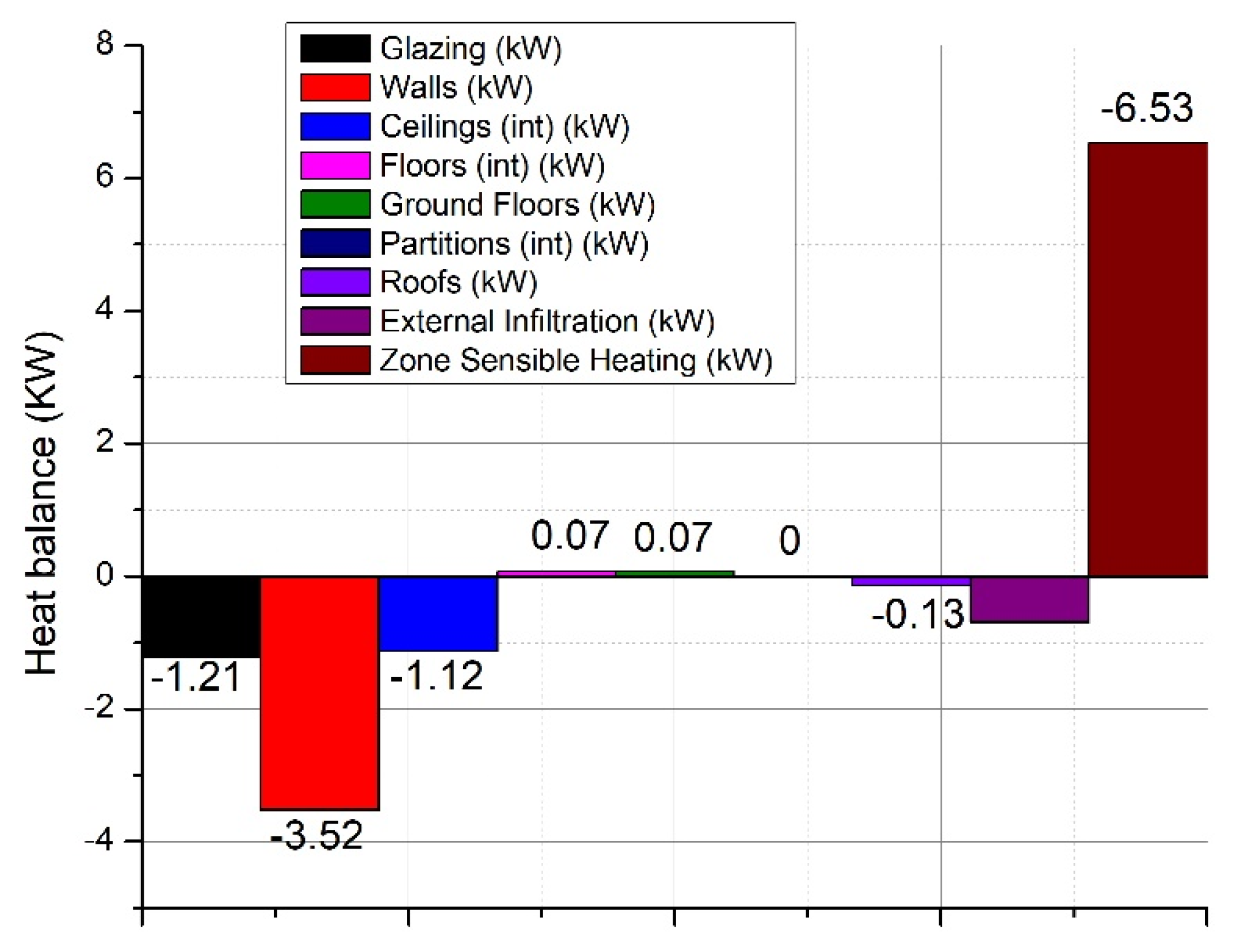
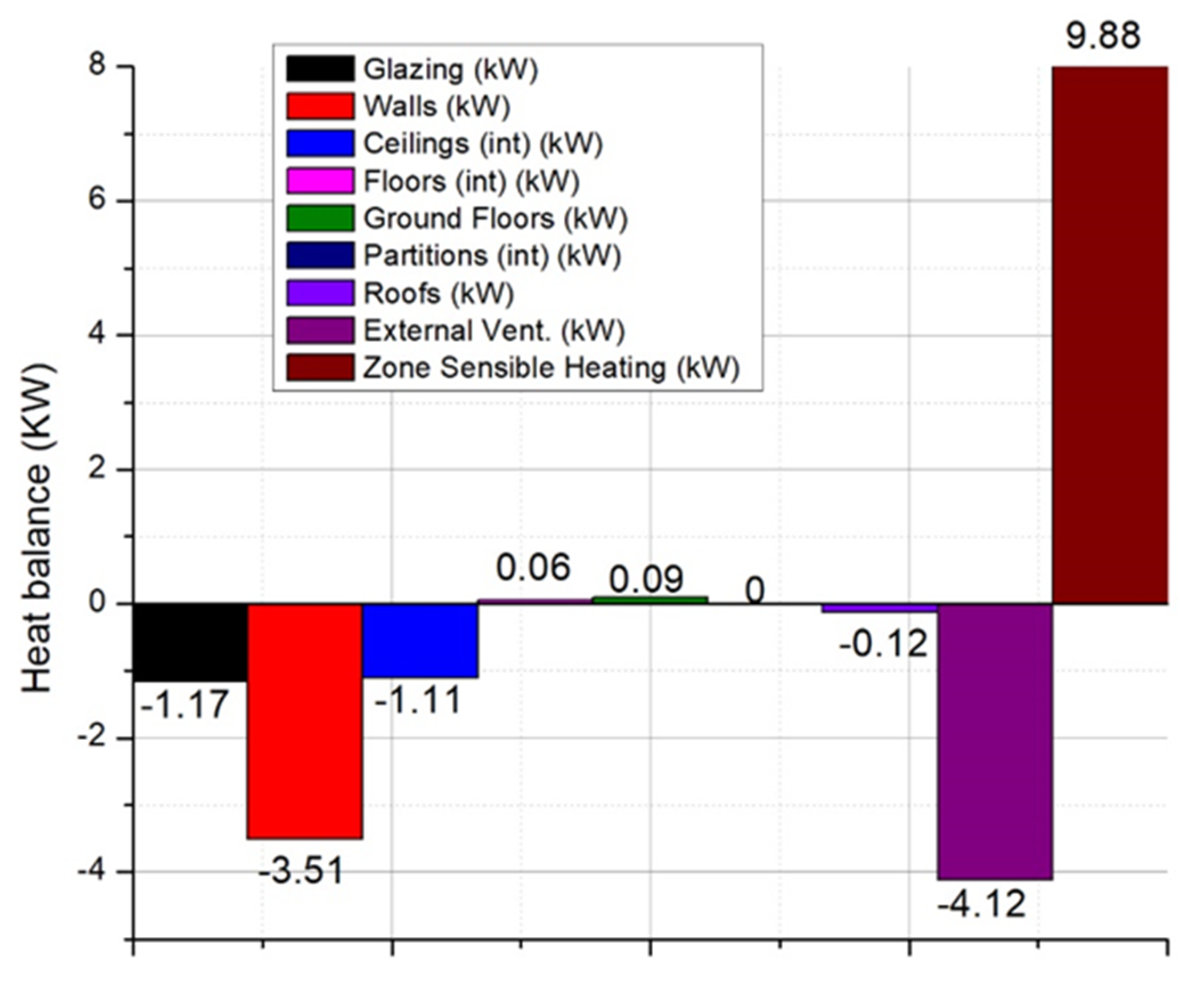
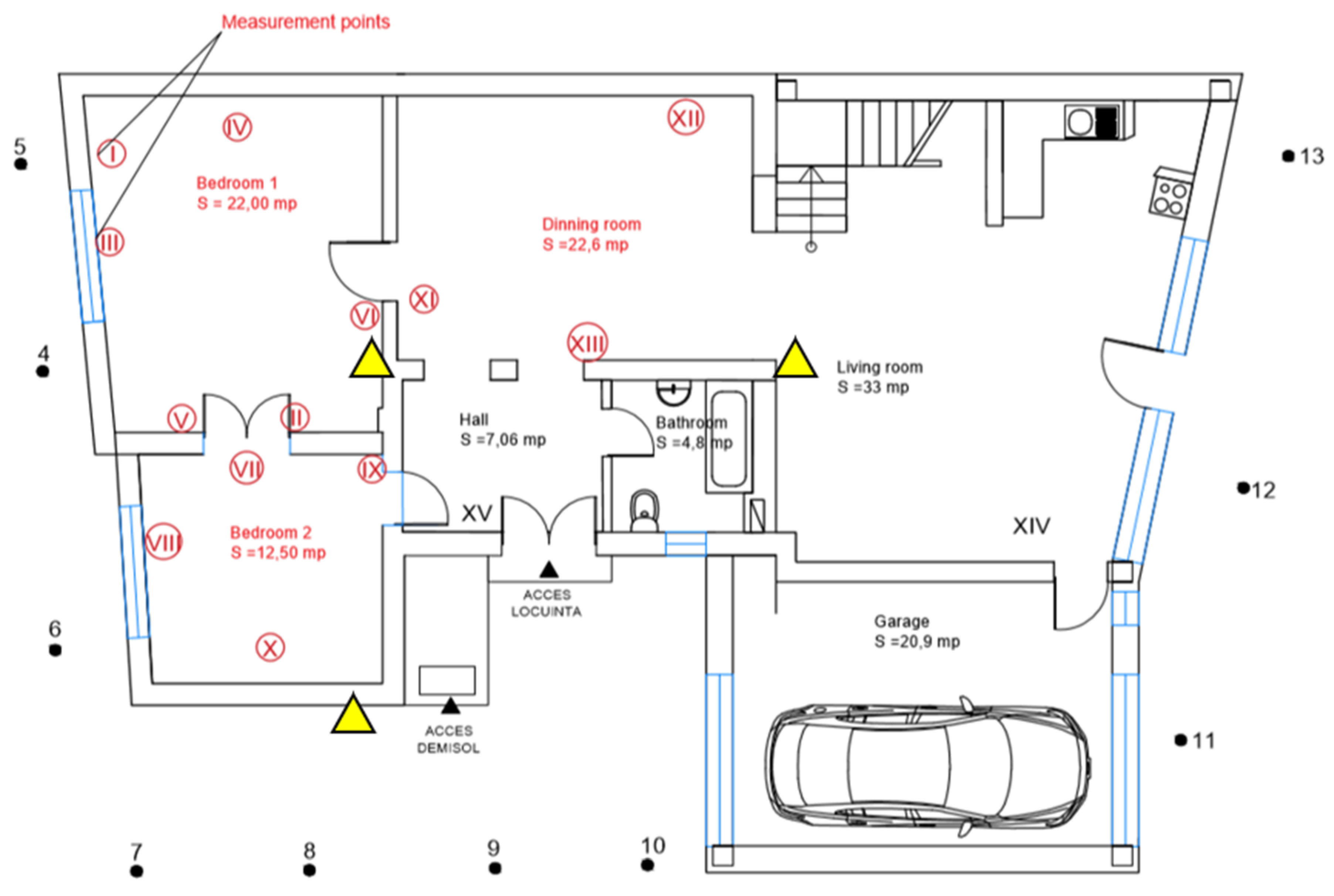


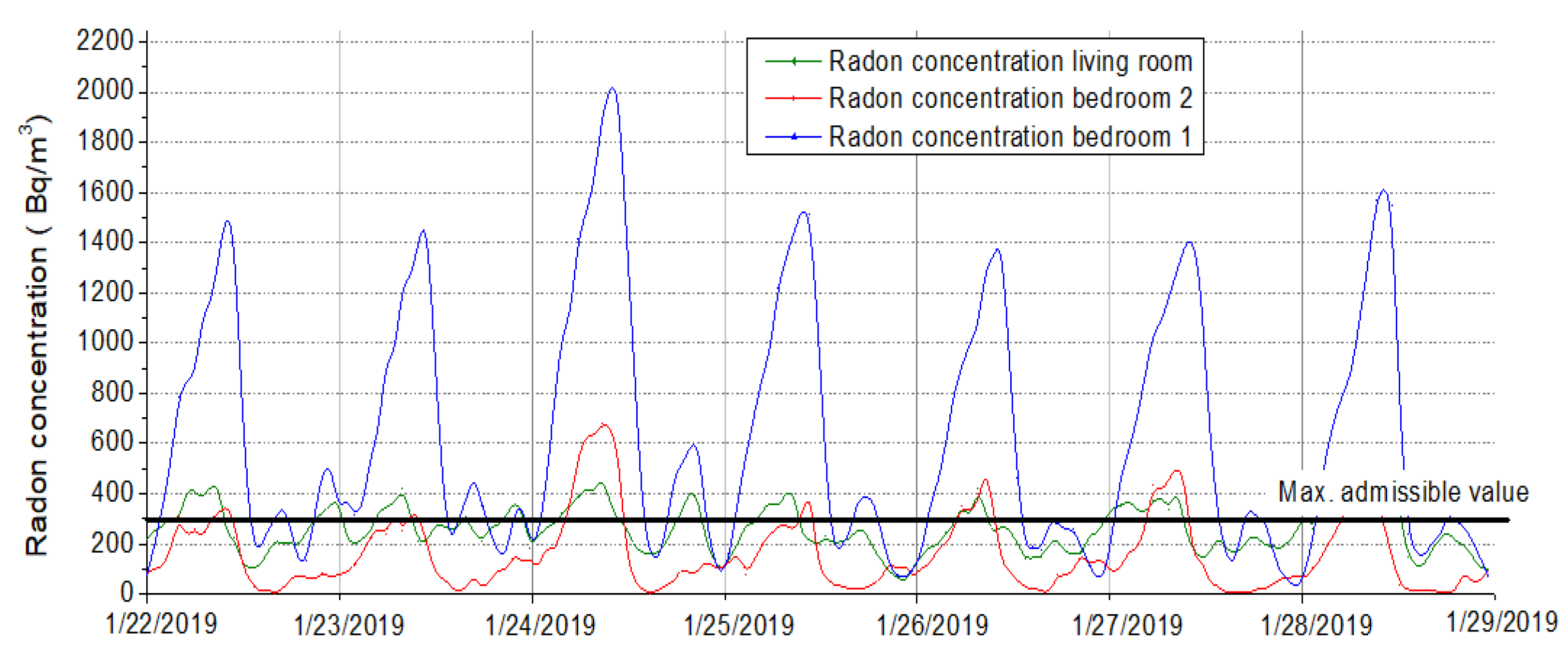
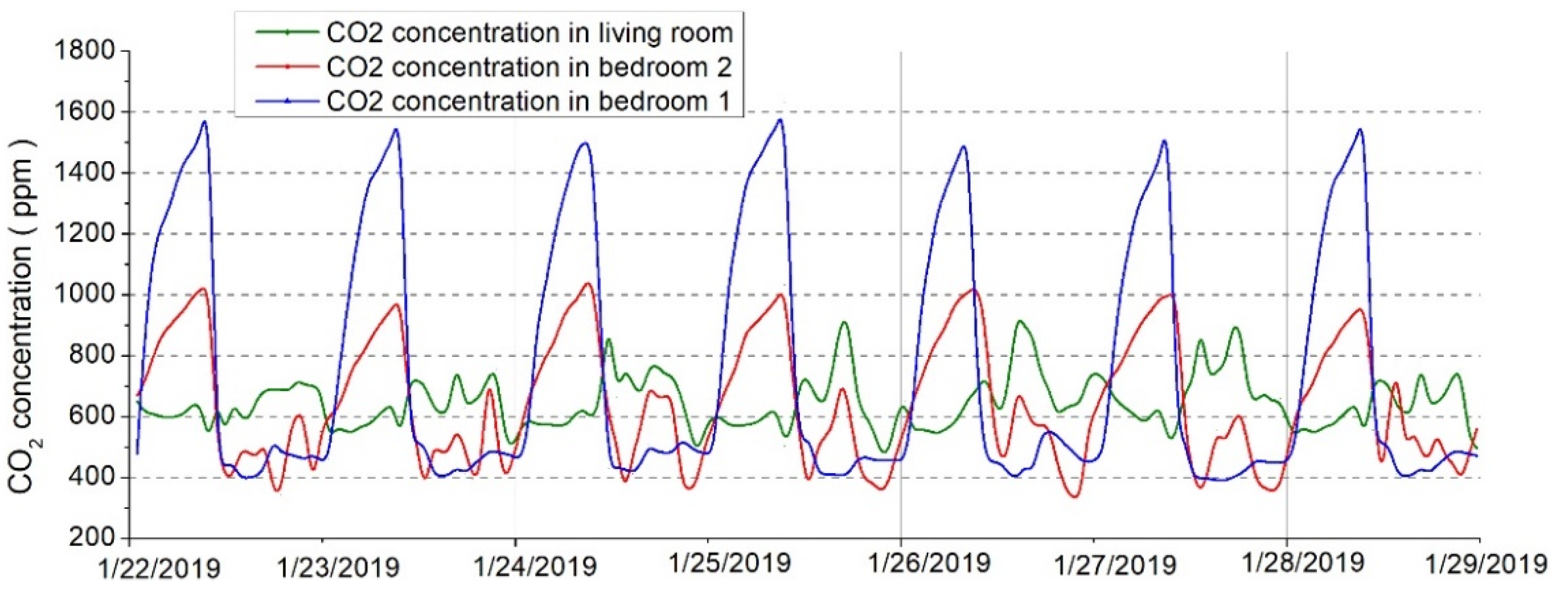

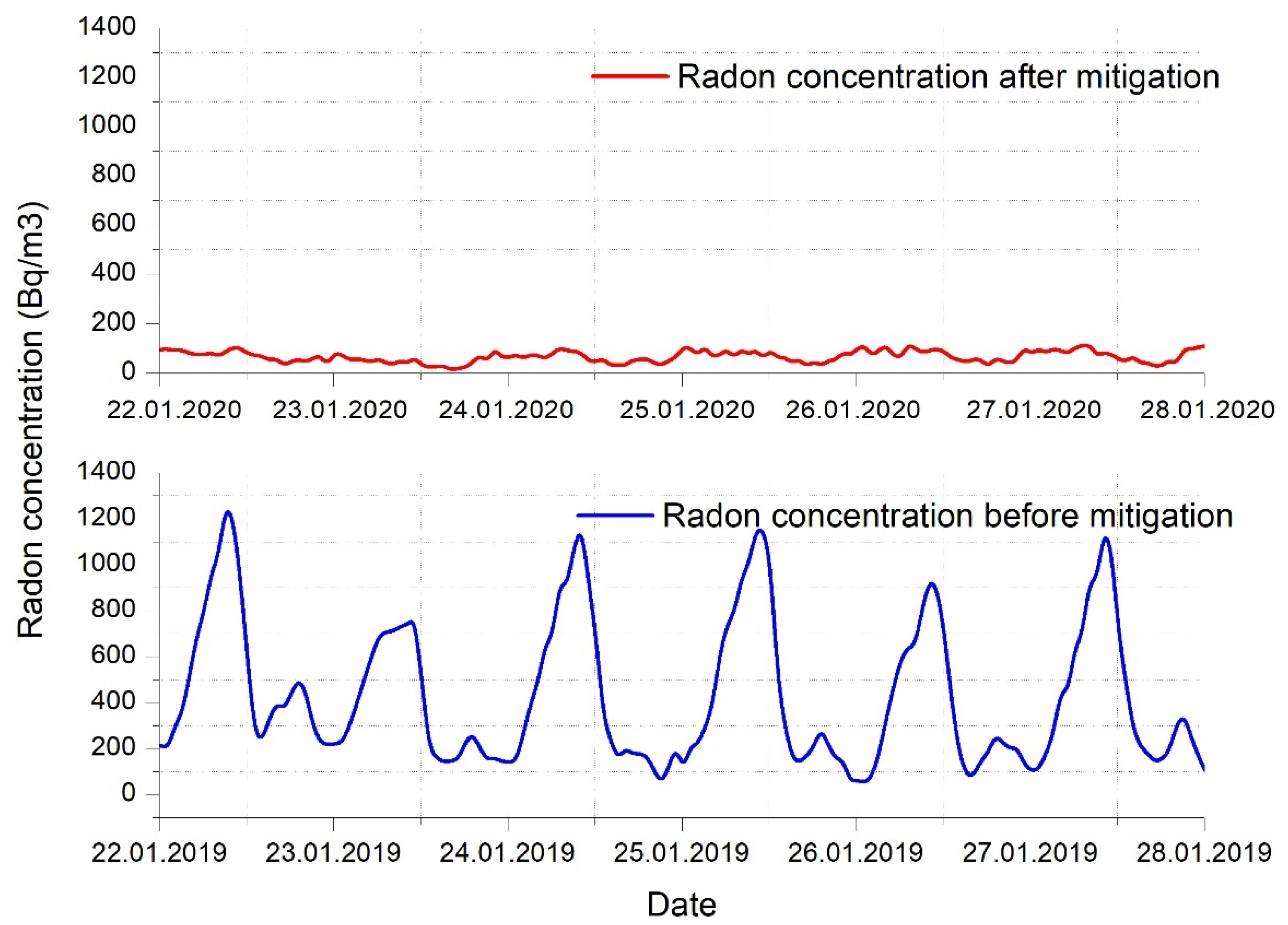
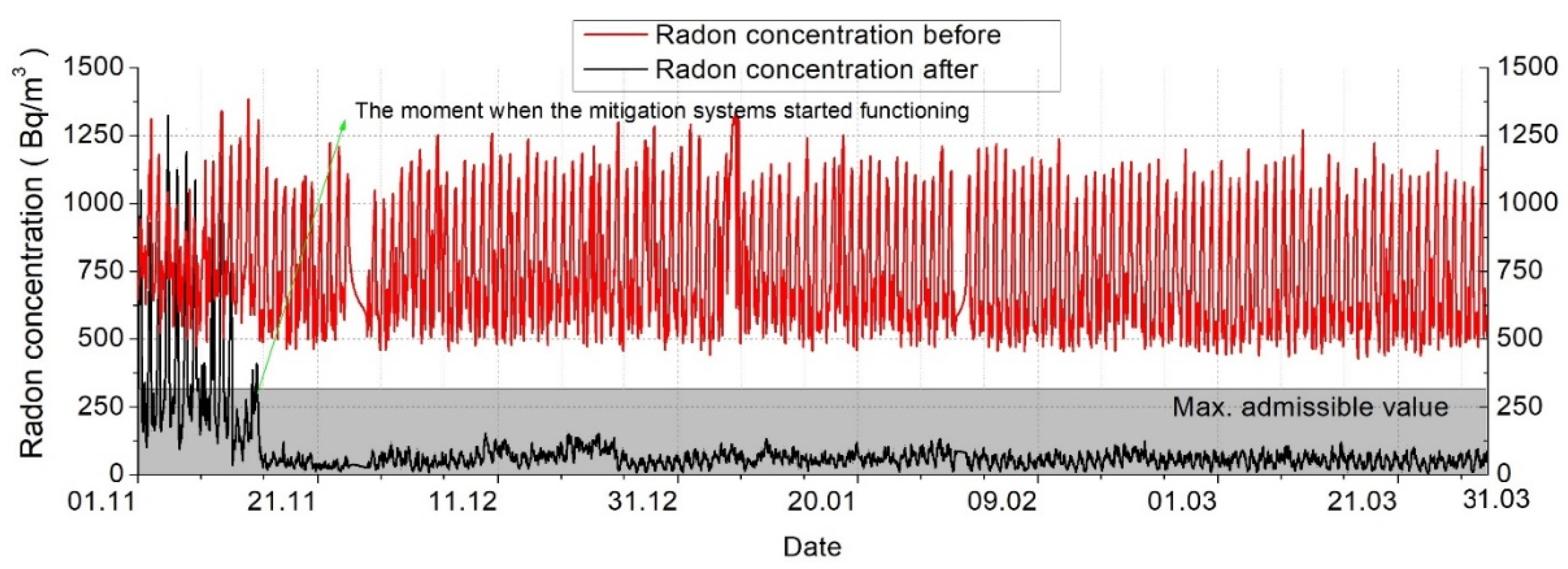
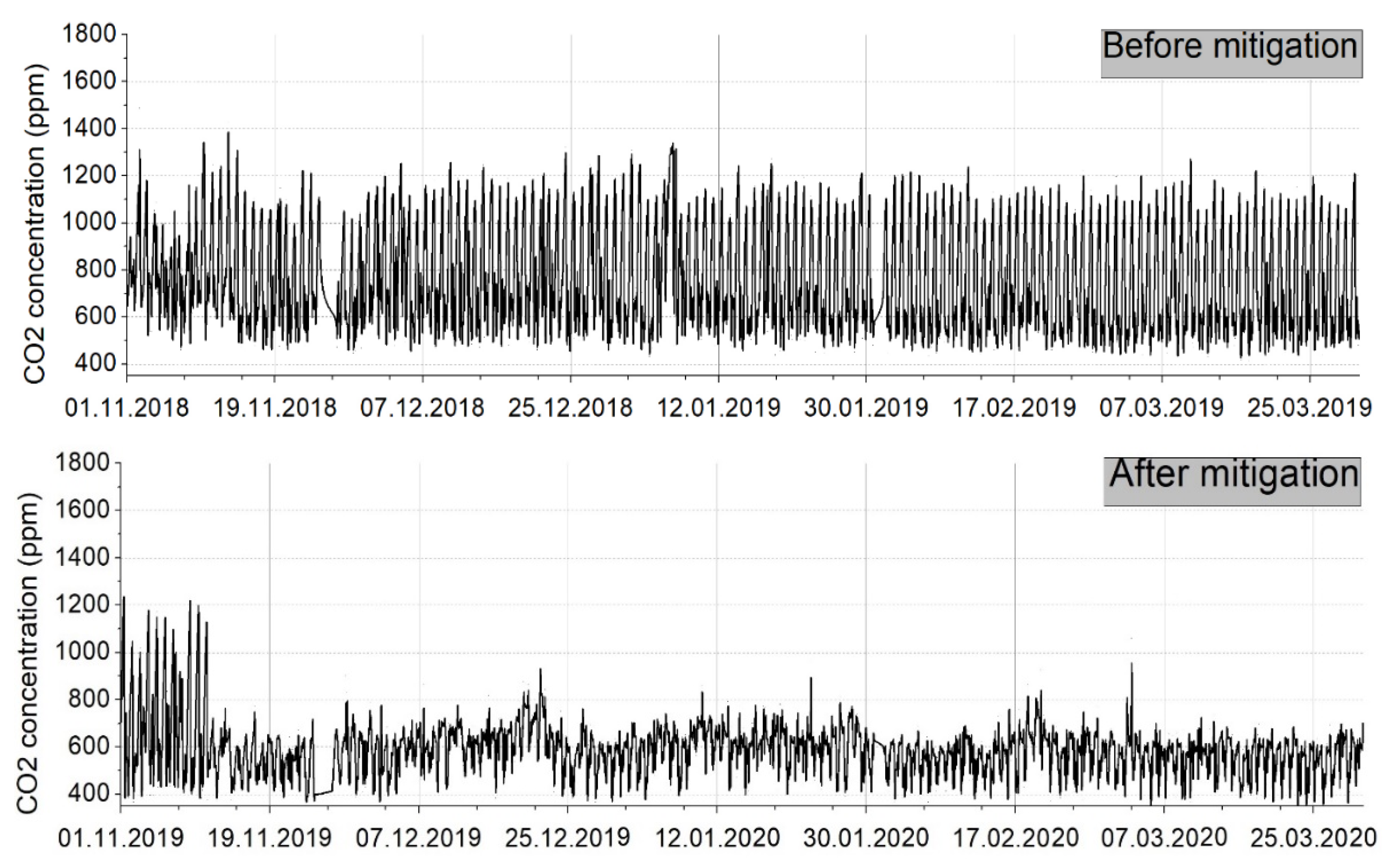
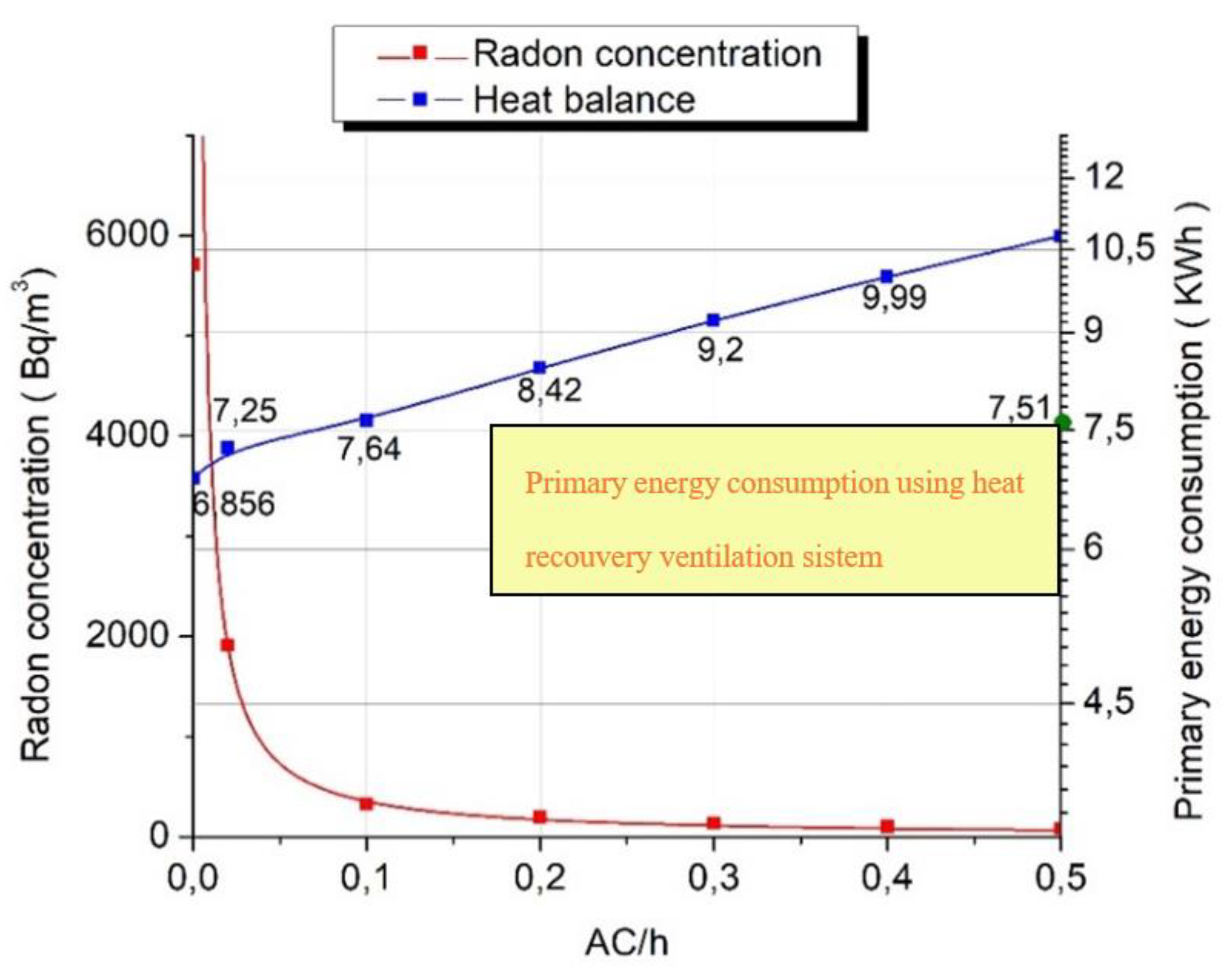
| Surface | [m2] |
|---|---|
| Construction surface | 137.98 |
| Total area | 275.95 |
| Heated area | 239.96 |
| Heated volume (total) | 599.90 |
| Wall exterior surface | 231.66 |
| Total glazed exterior surface | 31.76 |
| Roof surface | 137.98 |
| Floor surface in contact with basement/ground | 137.98 |
| Measurement sensitivity | 0.15 count/hour/Bq·m3 |
| Measuring range | 5–65,535 Bq·m3 |
| Measuring uncertainty | 15% at 300 Bq per 1 h |
| Measuring relative humidity range | 10–90% |
| Radon concentration results display | Short-term (1 h running average) Long-term (24 h running average) |
| Measurement sensitivity | 0.15 count/hour/ Bq·m3 |
| Intake/exhaust airflow | 20/40/60 m3/h |
| Acoustic pressure | 10/18/26 dB(A) |
| Heat exchanger efficiency | Up to 93% |
| Control system | automatic |
| Voltage supply | 230/50 Hz |
| Filter class | G4/F5/F7 |
| Maximum energy consumption by fans | 1.4, 2.3, 3.8 W |
| Exhausted airflow | 205 m3/h |
| Material | plastic |
| Intake/exhaust pipe diameter | 125 mm |
| Control system | automatic |
| Voltage supply | 230 V/50 Hz |
| Maximum fans consumed power | 58 W |
| Air Change Rate | The Primary Energy Consumption | |
|---|---|---|
| Winter Period | Typical Winter Week | |
| h−1 | kWh | kWh |
| 0 | 2,665,690 | 115,184 |
| 0.1 | 2,970,470 | 128,353 |
| 0.2 | 3,464,791 | 149,713 |
| 0.3 | 3,580,031 | 154,692 |
| 0.4 | 3,884,811 | 167,862 |
| 0.5 | 4,189,592 | 181,031 |
Publisher’s Note: MDPI stays neutral with regard to jurisdictional claims in published maps and institutional affiliations. |
© 2021 by the authors. Licensee MDPI, Basel, Switzerland. This article is an open access article distributed under the terms and conditions of the Creative Commons Attribution (CC BY) license (https://creativecommons.org/licenses/by/4.0/).
Share and Cite
Mareș, I.-C.; Catalina, T.; Istrate, M.-A.; Cucoș, A.; Dicu, T.; Burghele, B.D.; Hening, K.; Popescu, L.L.; Popescu, R.S. Research on Best Solution for Improving Indoor Air Quality and Reducing Energy Consumption in a High-Risk Radon Dwelling from Romania. Int. J. Environ. Res. Public Health 2021, 18, 12482. https://doi.org/10.3390/ijerph182312482
Mareș I-C, Catalina T, Istrate M-A, Cucoș A, Dicu T, Burghele BD, Hening K, Popescu LL, Popescu RS. Research on Best Solution for Improving Indoor Air Quality and Reducing Energy Consumption in a High-Risk Radon Dwelling from Romania. International Journal of Environmental Research and Public Health. 2021; 18(23):12482. https://doi.org/10.3390/ijerph182312482
Chicago/Turabian StyleMareș, Ion-Costinel, Tiberiu Catalina, Marian-Andrei Istrate, Alexandra Cucoș, Tiberius Dicu, Betty Denissa Burghele, Kinga Hening, Lelia Letitia Popescu, and Razvan Stefan Popescu. 2021. "Research on Best Solution for Improving Indoor Air Quality and Reducing Energy Consumption in a High-Risk Radon Dwelling from Romania" International Journal of Environmental Research and Public Health 18, no. 23: 12482. https://doi.org/10.3390/ijerph182312482






